This expert tutorial is all you need to make the best stuffed grape leaves or dolmas! These flavor-packed grape leaves are stuffed with a tantalizing mixture of rice; meat; and loads of fresh herbs and warm spices, then cooked in a bright lemony broth. I learned how to make stuffed grape leaves in my mother’s Mediterranean kitchen many years ago, and I’m sharing all her expert tips and tricks with step-by-step photos to show you. Vegetarian option included.
Stuffed grape leaves, also known as dolmas or dolmades, are arguably the most iconic Mediterranean food out there.
Homemade dolmas are one of my personal favorites, they will always remind me of my mother’s Mediterranean kitchen. I first learned to make them as a young teen in my mother’s Egyptian kitchen. It’s the sort of food that’s more fun to make in groups. So, the ladies of the family would gather around our small kitchen table, stuffing and rolling grape leaves, while catching up on life. Great memories!
If you’ve tried dolams at your local Greek or Mediterranean restaurant, you’re in for a treat! I’m about to show you step-by-step how to make the BEST stuffed grape leaves in your own kitchen for a fraction of the price. And you might want to grab a few friends to help you with this fun activity.
What are Dolmas: Stuffed Grape Leaves?
The word Dolma, from the Turkish verb Dolmak, basically means “to be filled,” referring to all sorts of stuffed foods from grape leaves to stuffed tomatoes, zucchini, or even bell peppers.
Now, you’ll find many variations of stuffed grape leaves recipes, from Turkey and Greece to Lebanon, and Egypt where it’s called Warak Enab (Grape Vine Paper.) Some recipes containing meat, others vegetarian. Some containing tomato sauce, others cooked in a lemony broth. I have yet to meet a stuffed grape leave, dolma, or Greek dolmades that I didn’t love, but this recipe is my absolute favorite.
What’s in stuffed grape leaves? In this recipe, grape leaves are stuffed with a tasty meat and rice mixture, seasoned with warm spices (allspice and cumin) and loaded with fresh herbs in the form of parsley, dill and mint. Then, once stuffed, the grape leaves are cooked in a tasty lemony broth.
I love to serve these dolmades with a side of Greek tztatziki sauce and Greek salad or tabouli for a light meal. But I have lots more ideas for you below, so keep reading on!
How to Make Stuffed Grape Leaves (Dolmas)
Step 1: Prepare the Grape Leaves
We’re using jarred grape leaves in brine, no cooking needed. But before using in this recipe, remove them from the jar and rinse well. Let them drain in a colander while you prepare the stuffing.
Step 2: Prepare the Stuffing
The stuffing here is made of rice, cooked ground beef, and a few chopped fresh herbs (parsley, dill, and mint).
First, rinse the rice and soak in water for 20 minutes (this is an important step, read on for more tips.) Then drain well. And while the rice is soaking cook the meat. Sautee finely chopped onions, add the meat and cook until fully browned. Be sure to drain any excess fat, then season the meat with kosher salt and pepper, allspice and cumin (so tasty!) Let cool.
Combine the meat, rice, and fresh herbs. Add a generous drizzle of extra virgin olive oil (I used Private Reserve Greek EVOO) and toss to combine. Add pinch of kosher salt.
Step 3: Stuff and Roll Grape Leaves
I like to start by preparing my cooking pot so that I can arrange the grape leaves as I stuff them.
Lightly oil the pot with some extra virgin olive oil, then add a few layers of grape leaves and top with sliced tomatoes. This protects the stuffed grape leaves touching the bottom of the pot from scorching.
To stuff grape leaves, work one leaf at a time. Lay the leaf flat on a cutting board with the more textured side facing you. Cut off the stem.
Take a heaping teaspoon of the rice stuffing mixture (a little bit less than 1 tablespoon) and place in the center of the leaf (close to where stem was).
Fold the sides over the filling and roll, keep tucking the left and right sides as you roll (think of this like you’re rolling spring rolls or cigars.)
Fold and roll grape leaves tightly enough but not too tight so the rice has room to expand as it cooks.
Step 4: Assemble Grape Leaves in Cooking Pot
Neatly arrange the grape leaves in rows, seam-side down, in your prepared pot, covering the circumference of the pot.
Then place a small plate inverted on top (this helps keep them in place while cooking.) Boil the water or broth and pour over the grape leaves, arriving at the top layer and somewhat covering (about 4 cups liquid, maybe a little more.)
Step 5: Cook Grape Leaves on Stovetop
Cover the pot with its lid and cook over medium heat for 30 minutes until the liquid has been absorbed. Uncover and remove the plate, then pour juice of 2 lemons. Cover again with the lid (no need for the plate at this point), cook on low heat for 30 to 45 more minutes or until fully cooked.
Let rest for 20 to 30 minutes, uncovered, before transferring to serving platter.
Tips for Making this Grape Leaves Recipe
I’ve been making grape leaves with my mom since my young teen years, she taught me a few important tips for making grape leaves. Here they are:
1. Soak The Rice in Water Before Using in the Stuffing. Two important ingredients of our grape leaves stuffing here are cooked ground beef and rice. It’s important to rinse the rice well to get rid of excess starch which causes rice to be sticky. Then soak the rice for 20 minutes or until you can break one grain of rice by pressing it between your index finger and your thumb. This way, your rice cooks evenly as the interior of the grain actually cooks before the exterior looses its shape. (I do the same when I cook my Lebanese rice and Greek lemon rice, works every time!)
2. Do NOT Over Stuff the Grape Leaves! Don’t over-stuff the grape leaves, remember that the filling is mostly of rice and it will expand as it cooks.
3. Roll tightly BUT allow for room for expansion. Roll the grape leaves tightly enough, so that they don’t unravel or become undone while cooking, but again remember rice will expand as it cooks so don’t fold too tightly or the rice won’t cook properly.
4. Keep the Grape Leaves from Floating or Unraveling While Cooking. To do this, make sure the grape leaves are assembled in your pot with the seam-side down. Then, add a small inverted plate on top of the assembled grape leaves in the pot to help keep them intact and prevent them from floating while cooking. Once the liquid has been absorbed, you can remove the plate to finish cooking as instructed.
5. Let Cooked Grape Leaves Rest for 30 Minutes before Serving. I know, it’s so hard not to immediately dig into those tasty grape leaves! But for best results, allow them to rest for 20 to 30 minutes so that any remaining liquids are absorbed and the leaves set nicely, plus they just taste better.
Vegetarian Grape Leaves Option
Since I published this post, I’ve received a number of requests asking for a vegetarian grape leaves recipe. I plan to put out a full tutorial on that, but here is essentially what you need to make this recipe vegetarian:
- The difference in vegetarian grape leaves is obviously in the stuffing mixture. You will need to omit the meat and add 1/2 cup more rice.
- Sautee the onions (no meat this time) until translucent. And add onions to the rice. Add spices (allspice and cumin) and pinch of salt and add the fresh herbs. Mix to combine and use this vegetarian mixture in the recipe as outlined.
Where to Find Grape Leaves?
Many grocery stores now carry jarred grape leaves in brine; check the international food section. I typically use the Orlando Brand grape leaves, and you can buy it here on Amazon(affiliate link.)
Can I use Fresh Grape Leaves to make Dolmas?
If you’re lucky enough to find fresh grape vine leaves, by all means, you should use them to make these dolmas. To use them in this recipe, first be sure to wash them well, then blanch them in boiling hot water. Remove from water using a slotted spoon and place them in a colander to fully cool and drain. From there, you can use them as indicated in the recipe. And if you have any extra, try using them to wrap Greek meatloaf!
What to Serve with Stuffed Grape Leaves
People often ask me if they should serve dolmas or stuffed grape leaves cold or hot. And what to serve with stuffed grape leaves?
Traditionally, Greek dolmas, particularly the meatless kind, are served at room temperature or slightly cooler as part of Mezze! That’s never a bad idea, and don’t forget some Tztaziki, creamy hummus, or some smoky Baba Ganoush to serve along.
But, since these are stuffed grape leaves with meat, you can absolutely serve them warm as the main course with a side of Tzatziki (or plain yogurt) and Greek salad or tabouli! You can also serve them as a next to Zucchini Fritters (Kolokithokeftedes); Greek lamb; grilled lamb chops; roast chicken; or Souvlaki!
Watch the video for how to make them:
SHOP OUR ONLINE SHOP FOR QUALITY OLIVE OILS, ALL-NATURAL SPICES AND MORE!
Print
Stuffed Grape Leaves (Dolmas)
- Total Time: 1 hour 45 minutes
- Yield: Up to 60 grape leaves 1x
Description
These flavor-packed grape leaves are stuffed with a tantalizing mixture of rice; meat; and loads of fresh herbs and warm spices, then cooked in a bright lemony broth. I learned how to make stuffed grape leaves in my mother’s Mediterranean kitchen many years ago, and I’m sharing all her expert tips and tricks with step-by-step photos to show you (be sure to read the post.)
Ingredients
- 1 16-oz jar grape leaves in brine (about 60 to 70 leaves), I used Oralndo brand (affiliate link)
- 1 1/2 cup short grain rice, soaked in plenty of water for 15 minutes, then drained
- Extra virgin olive oil (I used Private Reserve Greek EVOO)
- 1 large yellow onion, finely chopped
- 12 oz lean ground beef
- Kosher salt
- Black pepper
- 1 tsp allspice
- 1/2 tsp cumin
- 1/2 cup EACH chopped fresh parsley, fresh dill, and fresh mint
- 1 to 2 tomatoes sliced into rounds
- About 4 cups or more low-sodium chicken broth or water
- Juice of 2 lemons
Instructions
Prepare the Grape Leaves
- If using jarred grape leaves as I am here, remove them from the jar and discard the brine. Rinse the grape leaves well and place them in a colander to drain. (Later in the process, you’ll remove the stems before stuffing.) (See notes if using fresh grape leaves)
Prepare the Stuffing
- Soak the rice in plenty of water for about 15 to 20 minutes or until you are able to break one grain of rice easily. Drain well.
- While the rice is soaking, cook the meat. Heat 1 tbsp extra virgin olive oil in a large skillet. Add onions and cook briefly, about 2 minutes or so, tossing until translucent. Add the meat and cook till fully browned, tossing occasionally. Drain any excess fat, then season the meat with kosher salt, pepper, and spices. Toss to combine. Remove from heat and set aside to cool.
- In a mixing bowl, combine the meat, drained rice, and fresh herbs. Season lightly with kosher salt. Add a generous drizzle of extra virgin olive oil, and mix so that everything is well-incorporated.
Stuff Grape Leaves, Assemble, and Cook
- Prepare a heavy cooking pot and lightly brush the bottom with extra virgin olive oil. Arrange a few grape leaves in the bottom (I used the leaves that didn’t look too great here and made three layers to protect the stuffed leaves from scorching later.) Top with sliced tomatoes.
- To stuff the grape leaves, you will work one leaf at a time. Place one grape leave on a cutting board the textured/rough side facing you. Take 1 heaping teaspoon of the filling and place in the center of the leave, then fold the sides over the filling and roll (think about this like rolling spring rolls or cigars.) Repeat with the remaining grape leaves or until you’re out of stuffing.
- Neatly arrange the grape leaves in row, seam side down, in your prepared pot, covering the circumference of the pot. Then place a small plate inverted on top. Boil the broth or water and pour over the grape leaves, arriving at the top layer and somewhat covering (about 4 cups liquid, maybe a little more.)
- Now cover the pot with the lid and cook over medium heat for 30 minutes until the liquid has been absorbed. Uncover and remove the plate, then pour juice of 2 lemons. Cover again with the lid (no need for the plate at this point), cook on low heat for 30 to 45 more minutes or until fully cooked.
To Serve
- Remove grape leaves from heat. Allow to rest uncovered for 20 to 30 minutes before serving.
- Add a generous drizzle of quality extra virgin olive oil (I used Private Reserve EVOO), and transfer to a serving platter.
- Serve with a side of Greek Tzatziki sauce or plain yogurt and wedges of lemon. (More suggestions for what to serve along in the post above)
Notes
- Cooks Tips for Best Results: 1) Be sure to soak the rice before using, this allows it cook well and more evenly. 2) Don’t over-stuff the grape leaves, remember that the filling is mostly of rice and it will expand as it cooks. 3) Roll the grape leaves tightly enough so that they don’t unravel or become undone while cooking, BUT again, remember rice will expand as it cooks, so don’t fold too tightly or the rice won’t cook properly. 4) Adding a small inverted plate on top of assembled grape leaves in the pot helps keep them intact and in place and prevents them from floating while cooking. Once the liquid has been absorbed, you can remove the plate to finish cooking as instructed. 5) Once cooked, allow the grape leaves to rest for 20 to 30 minutes so that any remaining liquids are absorbed and the leaves set nicely, plus they just taste better.
- Vegetarian Option:The difference in vegetarian grape leaves is obviously in the stuffing mixture. You will need to omit the meat and add 1/2 cup more rice. Sautee the onions (no meat this time) until translucent. And add onions to the rice. Add spices (allspice and cumin) and pinch of salt and add the fresh herbs. Mix to combine and use this vegetarian mixture in the recipe as outlined.
- If using fresh grape leaves: wash them very well and blanch them in boiling hot water. Remove from water using a slotted spoon and place them in a colander to fully cool and drain.
- Leftovers: Store properly in the fridge in a tight-lid, refrigerator-safe container for 3 to 4 days. You can enjoy them cold or reheat. To reheat, place in a pot with a tiny bit of liquid, cover and heat over medium-low heat until warmed through.
- Prepare-Ahead Tips: 1) You can prepare the stuffing 1 to 2 nights in advance and keep refrigerated in a tight-lid glass container in the fridge. 2) You can also roll the grape leaves and assemble them fully up to 1 night in advance and keep refrigerated until ready to cook. I like to take them out of the fridge for a bit before cooking so they are not so cold.
- Recommended for this Recipe: Visit our Online Shop to browse our Greek extra virgin olive oils and all-natural spices including allspice and cumin used in this recipe!
- Prep Time: 45 mins
- Cook Time: 60 mins
- Category: Entree
- Method: Stove Top
- Cuisine: Mediterranean
Nutrition
- Serving Size: 1 stuffed grape leaf
*This recipe first appeared on The Mediterranean Dish in 2014 and has been recently republished with new media and information for readers benefit. Enjoy!

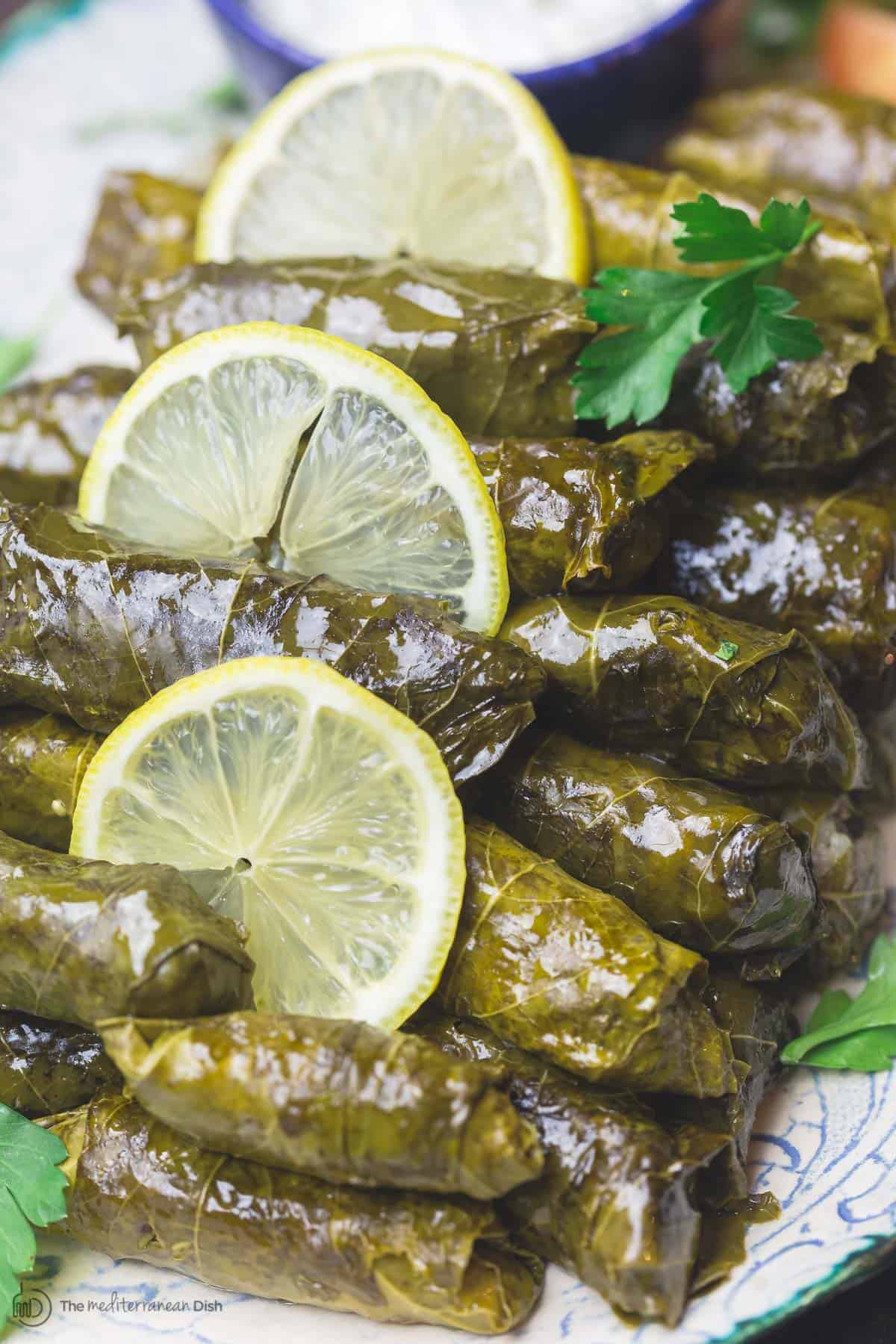
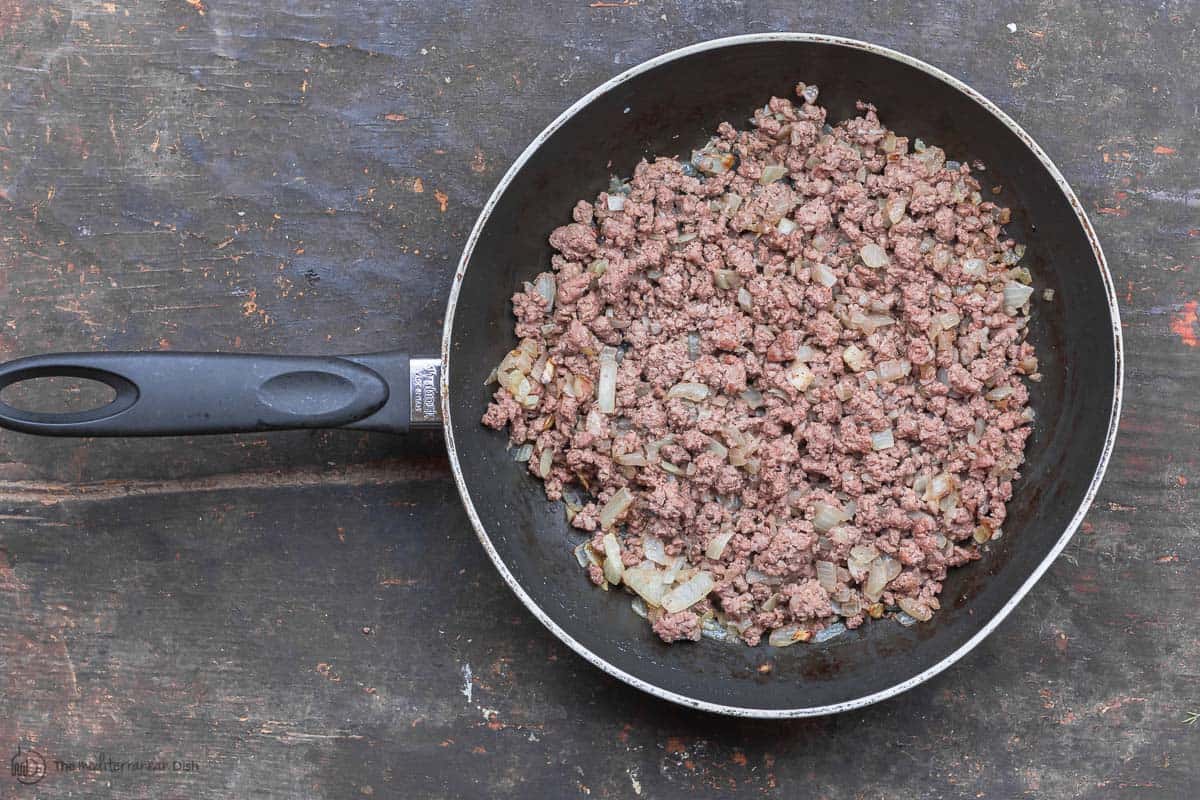
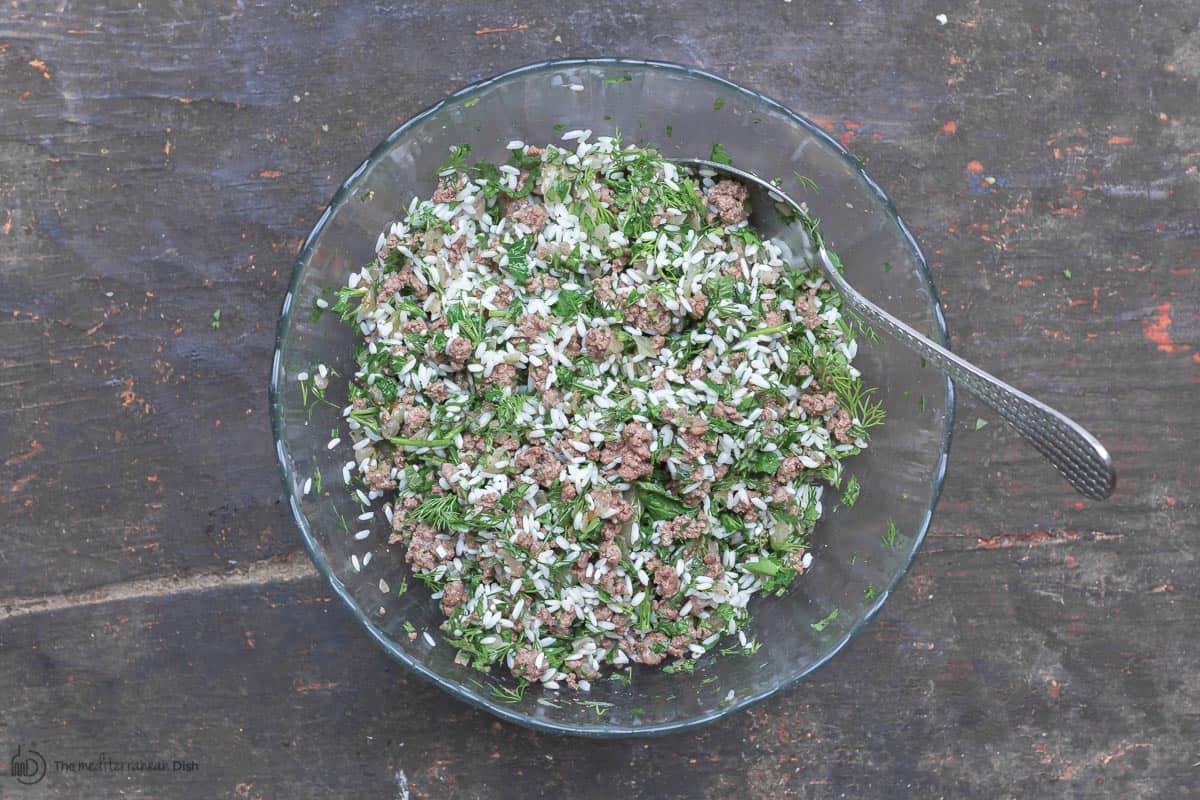
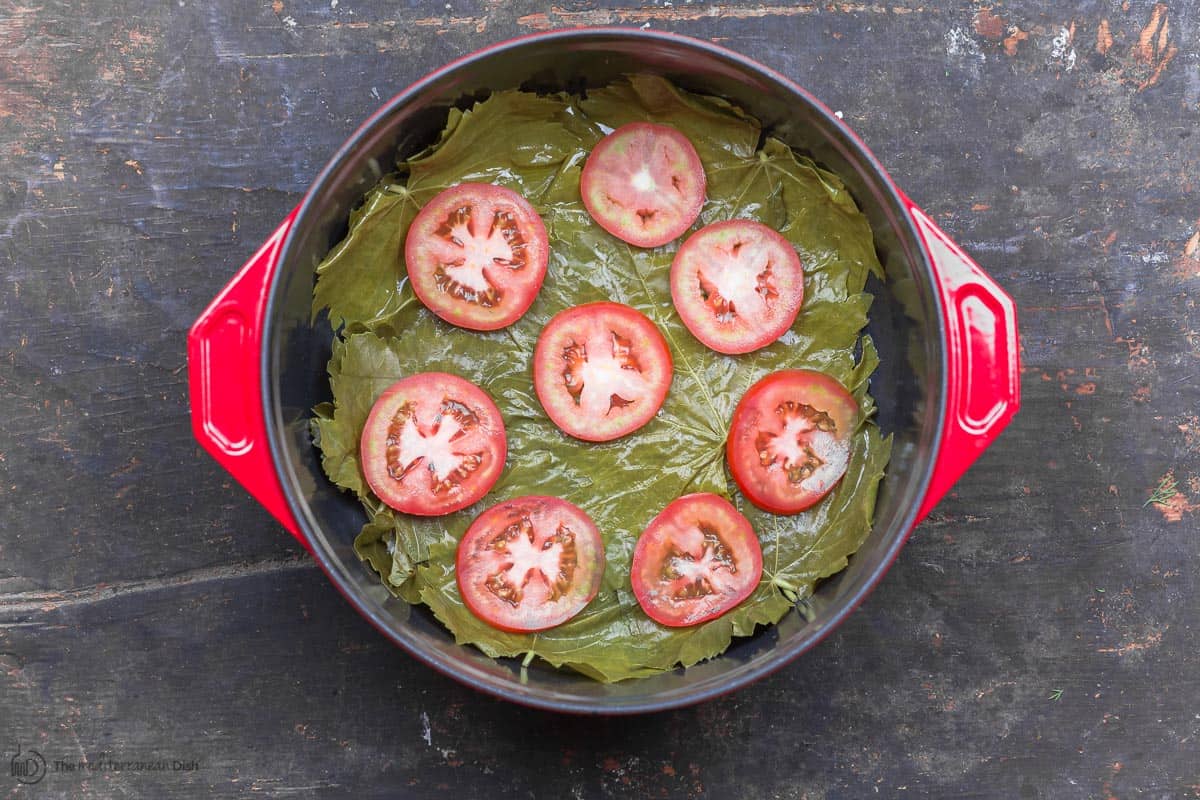
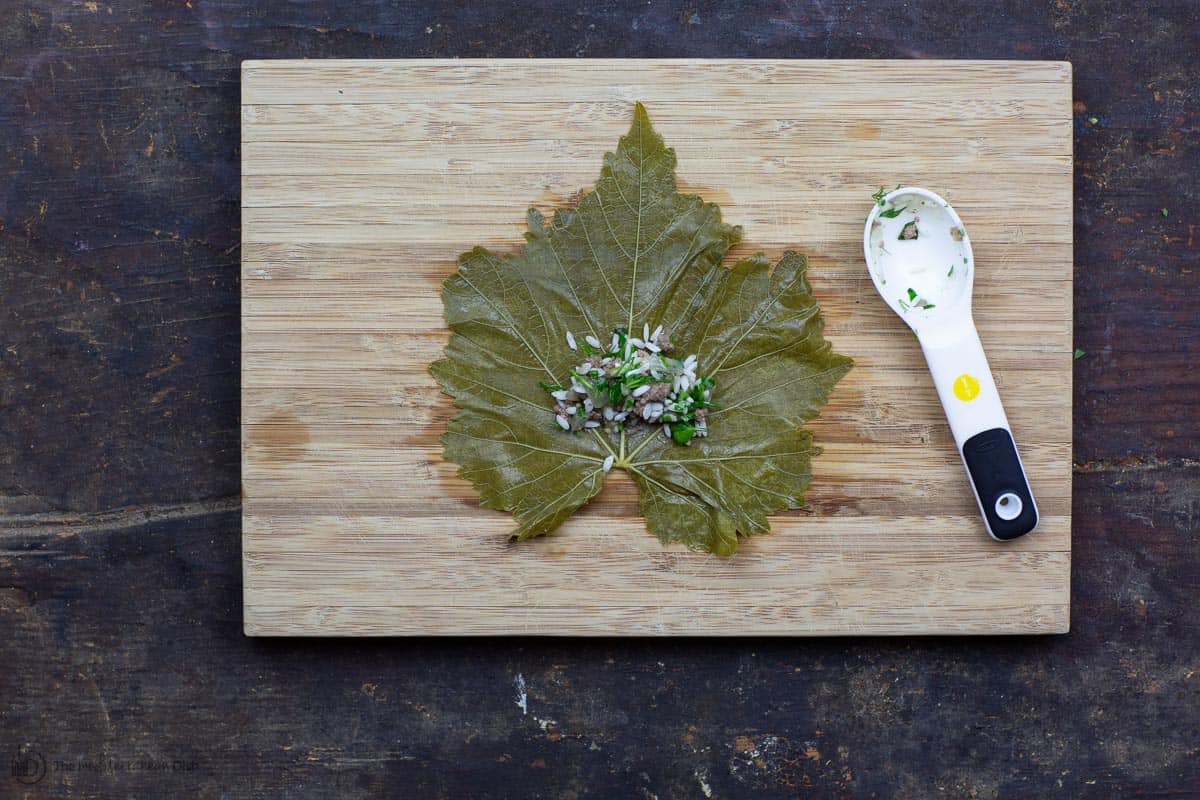
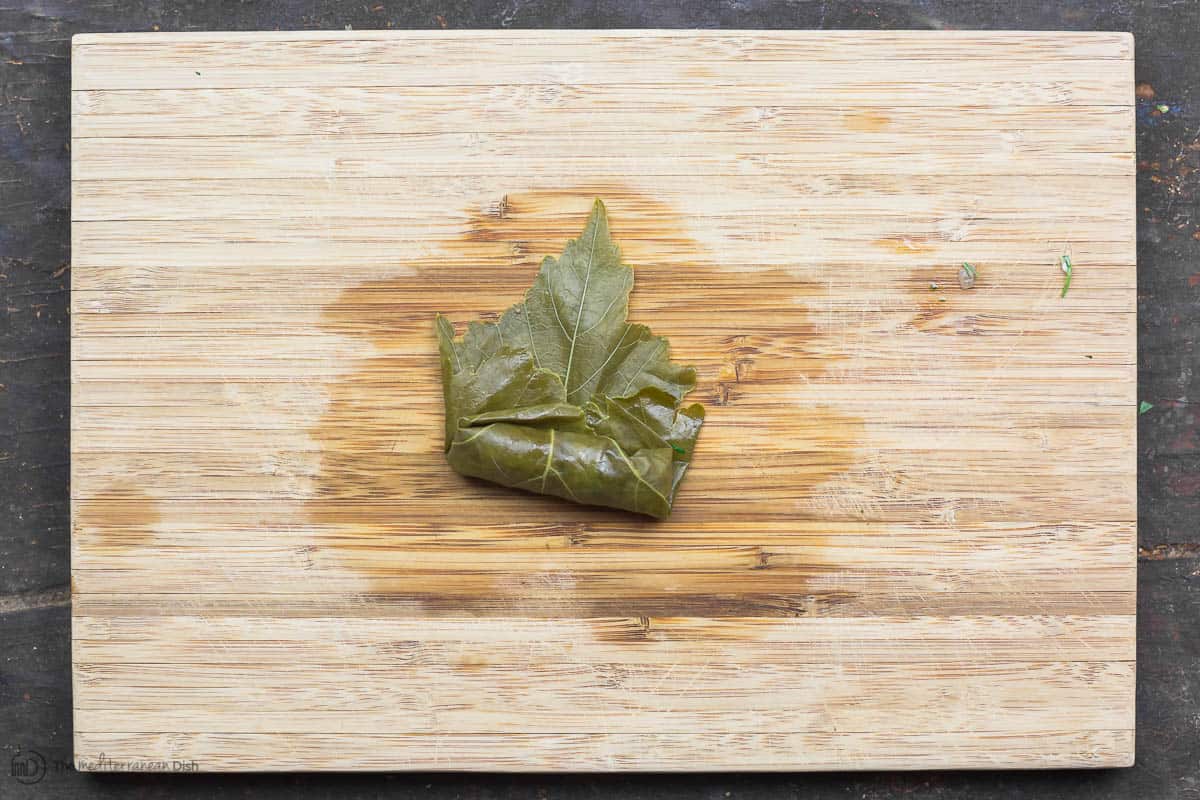
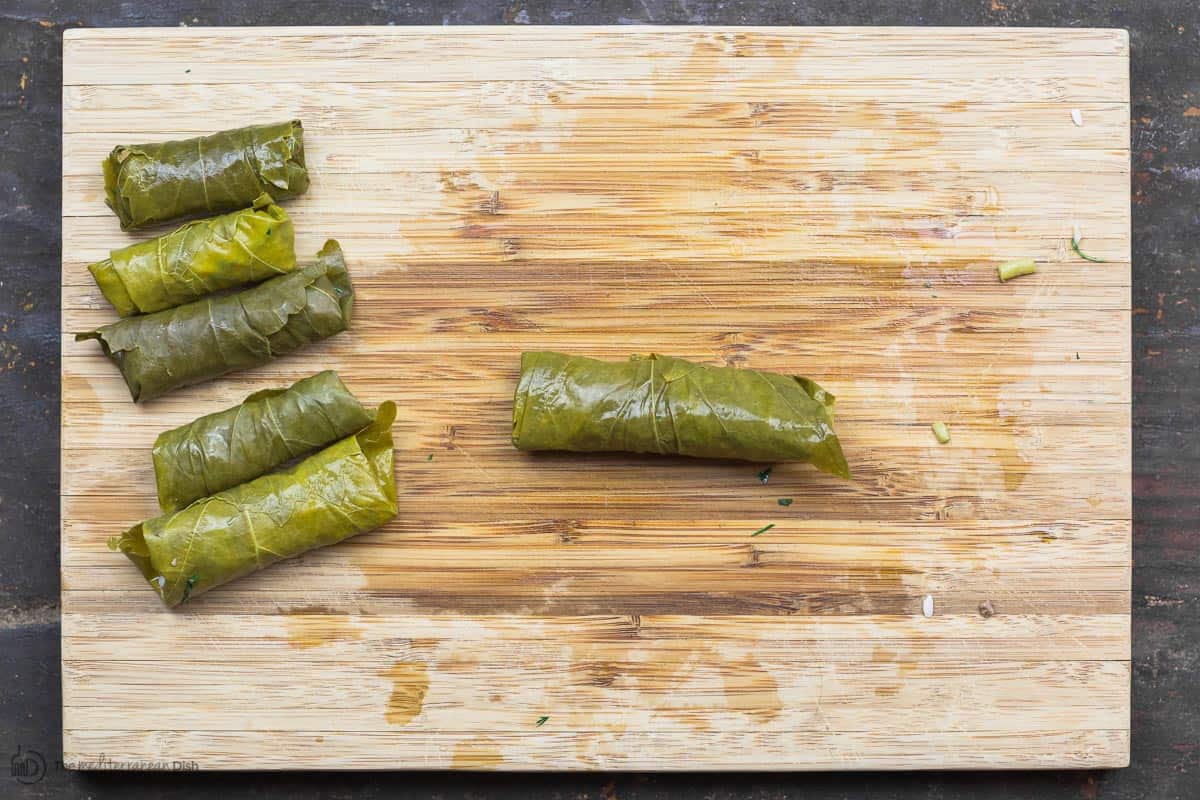
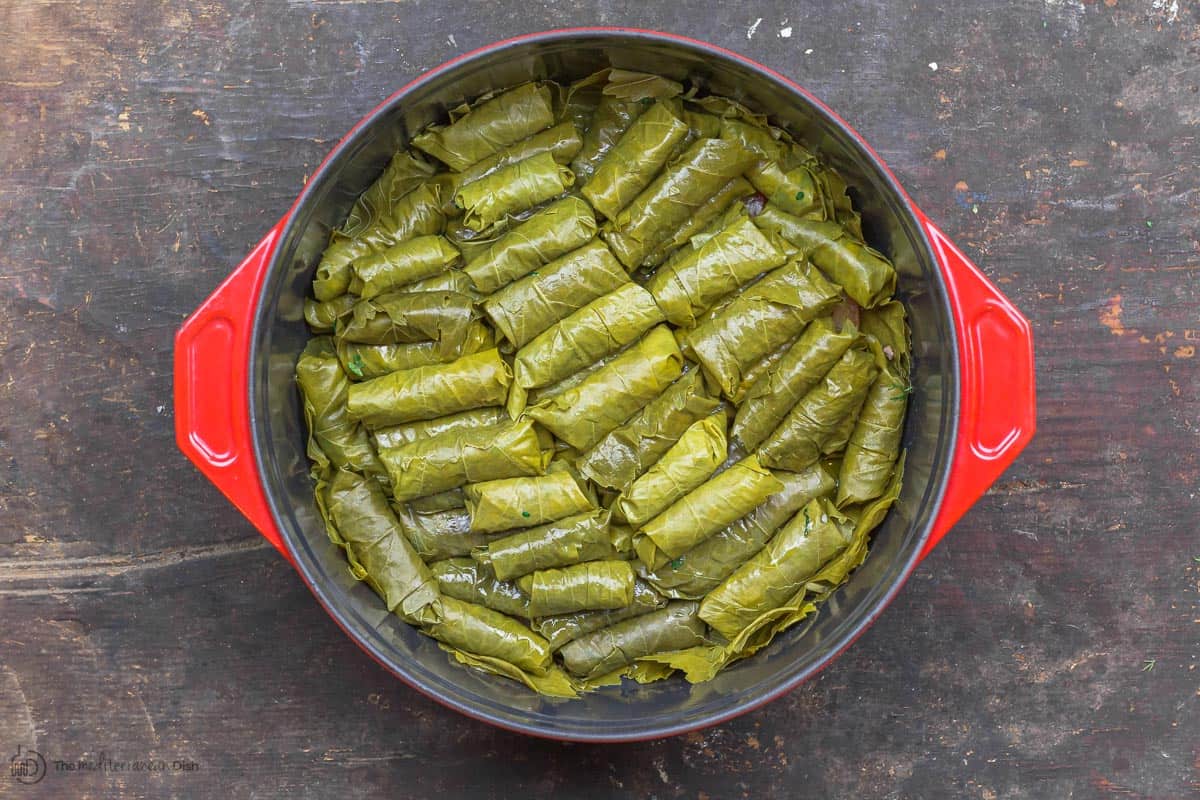
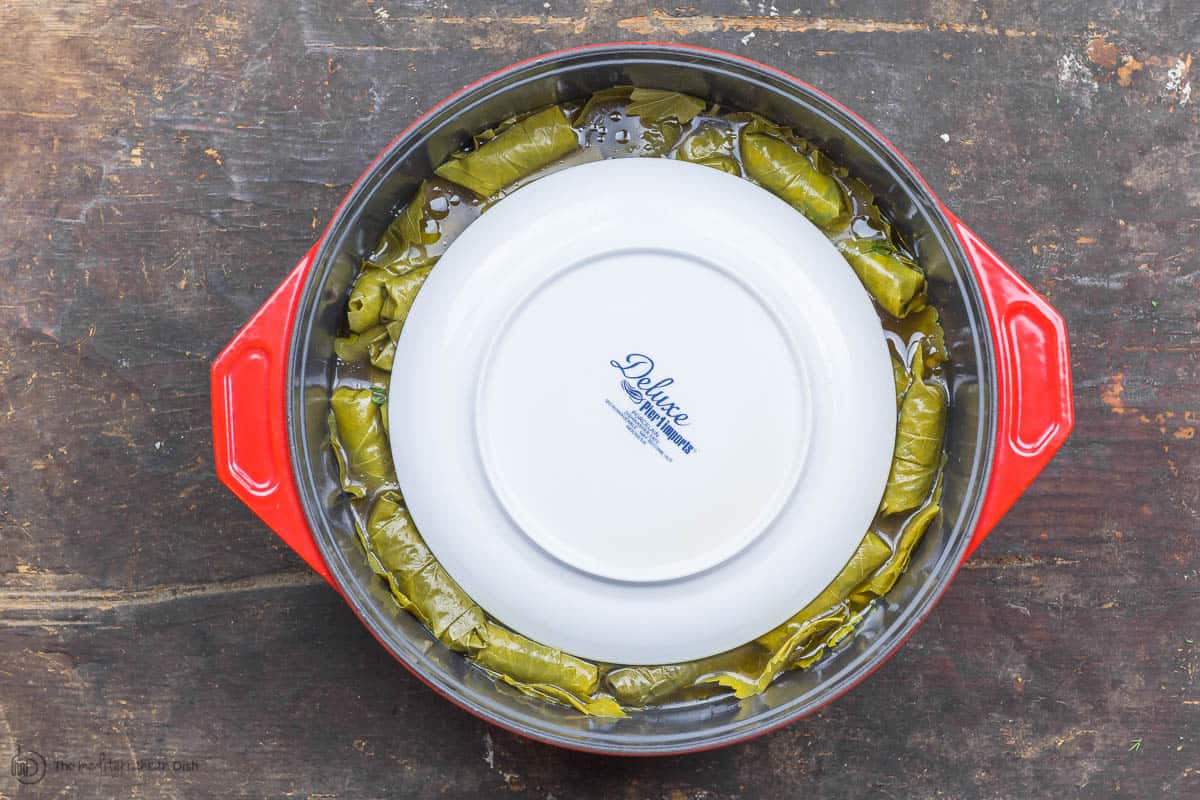
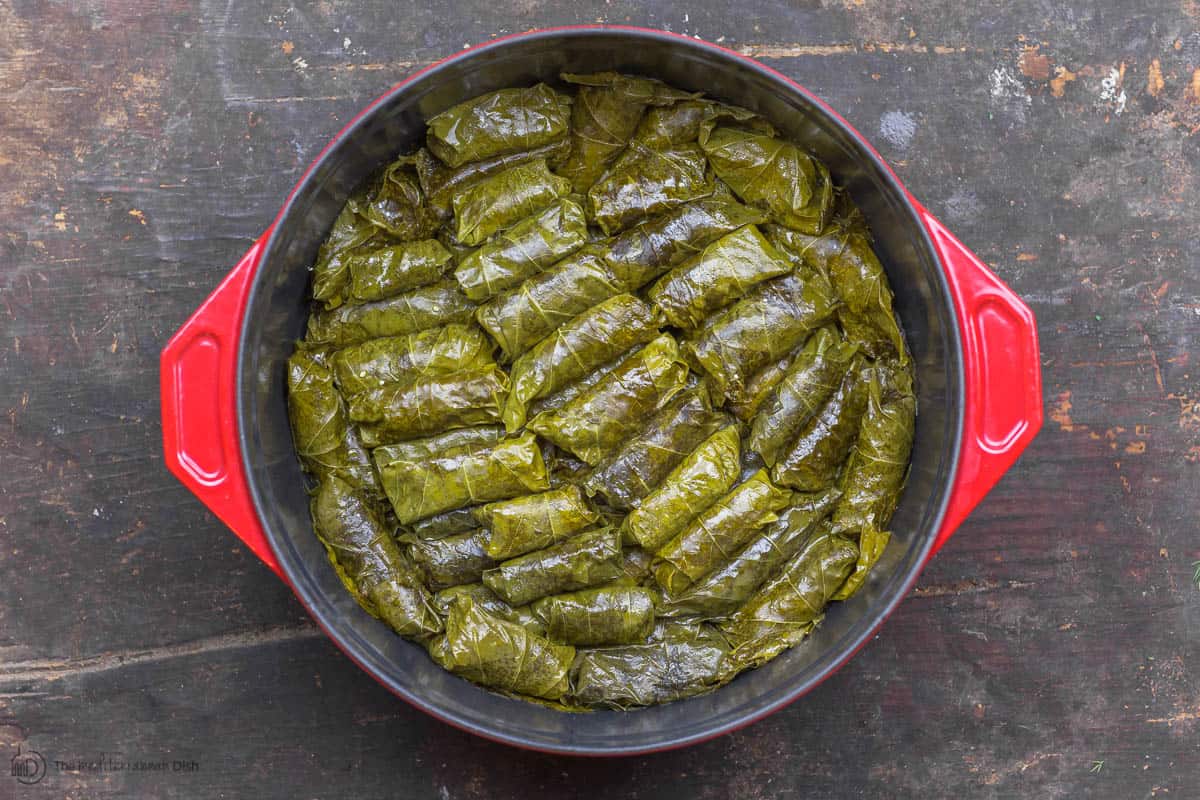
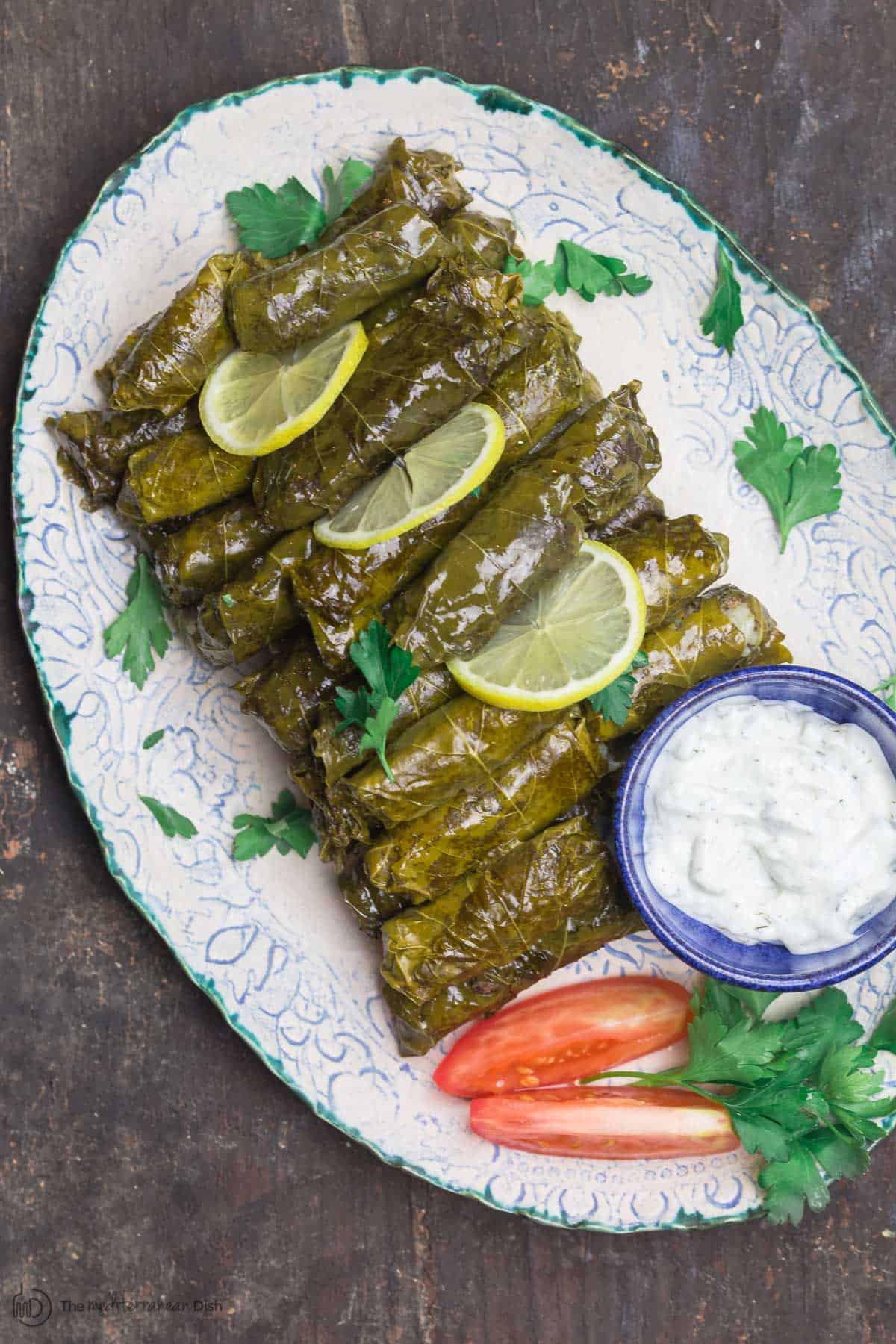
Can fresh grape leaves be used instead of grape leaves in a jar?
Oh nevermind I guess I didn’t read it all the way
I am Greek. I made these yesterday for my family and another Greek family as a side dish to my grilled pork chops and lamb chops. They were a hit! Because time was limited and to minimize cleanup, I sauteed the onions and browned the meat right in my dutch oven. I used the 2X recipe and rounded it up to the 2lb. pack of ground beef I had, the whole, “bunches” of dill, parsley and mint (minus the stems). I lined up three rows of leaves and stuffed and rolled in batches of 18. I didn’t remove the stems! I preheated my oven to 300 degrees F, baked them for 30 minutes, did the lemon juice and baked for another 45 minutes. I let them rest while I was grilling. They were amazing. The leaves and the stems were so tender, nobody even knew they were left on! Thank you for this recipe!
Thanks so much for sharing, Jim! So glad you enjoyed it.
Omg!!!! I been trying to find a recipe where they are baked forever! Wnen i was little i went over to my friends house for dinner and her mom made dolmas it was my first time ever having them, she had a grape vine in the back.and used the leaves from that, it was hands down the best dolmas iv ever had in my entire life! She was from Jerusalem but till this day iv never had dolmas like that. I once worked at a authentic greek restaurant and they were cooked more like this re recipe still delicious but been searching for what you just mentioned about baking!
Yay! Hope you enjoy them, Marissa!
Thanks Jim. Like a kitchen boss.
Nice recipe and instructions. They’re still cooking, and for some reason the liquid hasn’t evaporated. But rice seems cooked. Is it normal to have lots of left over liquid?
I typically don’t have “a lot” of liquid left over, but there is some.
I am truly thankful to the holder of this website who
has shared this great article at at this place.
So glad you enjoyed the post, Kellie!
The proportions are perfect. I loved the dill mint parsley combo. I only diverted from the recipe by adding a bit of garlic powder. I loved this dish. A very long process of rolling but fun with others at a special occasion.
So glad you enjoyed the Dolmas, Fran!
One of my sons has been asking me to make them and I finally bought some grape leaves in brine at a Middle Eastern grocery/cafe near Atlanta, GA. You have provided excellent, easy-to-follow instructions and photos. Looking forward to trying it!
Can’t wait to hear how they turn out!!
Is short grained rice a must use or can I use whatever white rice I have?
You can try other white rice, Gretchen. I typically use the short grain or medium grain rice here.
Very silly question I no but what size pot do u use please I’m looking at casserole pot I think that’s the same as picture but not sure what size to go for please help?
Hi Leanne. A 5-quart pot should work well for you.
Thank you for clear directions on how to prepare one of my favorite recipes.
Oh so glad! thank you
I just made these and they are delicious! I struggled with rolling them but they still turned out nicely.
I’m curious – what do you do with the leftover leaves and tomatoes in the pot? It seems like they could have a life of their own in another recipe. :~)
Thank you!
So glad you enjoyed them, Merry! We typically eat the cooked leaves and tomatoes at the bottom maybe with a dollop of tzatziki sauce. But you could also cut them up and toss them with cooked rice or cooked couscous for another meal.
Made these for dinner last night. Very easy to follow directions & absolutely delicious grape leaves. Made your tzatziki sauce for dipping & it was perfect. Thank you!
Awesome, Michelle! So glad!
Yummmm! I added extra rice instead of beef to make them vegetarian and added the tomatoes to the stuffing instead of putting them on top. This recipe is a keeper!
I’m so glad you enjoyed it, Emily!
This recipe was phenomenal! I’m Greek and cook Greek food here and there and tried to make dolmades probably 10 years ago or so and didn’t turn out ( from
What I remember). This recipe was easy to follow and they came out deelish!! Thank you! Can’t wait to share them with my friends and family ! Might have just eaten 4 of them!
I’m so glad this recipe worked out so well for you!!! Yay!!!!
I would go to Greek Town in Chicago and get the best Dolmas. However, it was warm. What to do to make them warm ? Also, any ideas where I would get fresh grape leaves sent to Tucson Arizona? Thank you !
Hi there. I am not aware of particular places that sell fresh grape leaves in the Tucson area. We often use jarred grape leaves like what you’ll find here: https://amzn.to/3fShzxr (affiliate link)
This was my first time making dolmas, and it was just as tedious as my Greek mom always makes it look. With that being said, I was proud to take a stab at it. Some of my leaves were a bit small, making for pretty wimpy dolmas, but overall I followed instructions to a T. The finished product has a nice flavor, but the leaves are a little hard to chew through compared to what I’ve eaten in the past. What do you recommend for my next try?
Thanks for this recipe either way, happy to give it another go in the future!
Hi Alex! So glad to hear this was a success for you! And yes, dolmas are a bit of a labor of love! I would say you might like to cook your grape leaves a little bit longer and watch the liquid amount…maybe adding just a tiny bit more liquid sometime later in the process and then letting them simmer a bit longer, covered, will help with this. Cooking time does vary.
This was my second time making stuffed grape leaves. The first time was years ago, and they flopped, mostly because I overstuffed them. I hesitated to ever try again, until I was recently in an Armenian market and lo and behold – fresh grape leaves! So I had to try.
Well, I didn’t overstuff them, having learned that lesson from my prior failure. They came out looking nice. But – the grape leaf veins are really tough, to the point of inedible. I soaked them for about 15 minutes before starting to roll them. I cooked them about one hour and then took one out and had a bit to see if the rice was cooked. (These were vegetarian version.) The rice is cooked, but I absolutely could not even chew the stems.
I really like cooking from scratch (and do, about 95%). So it would please me no end to be able to make these again, whenever I find fresh grape leaves. But not if this is the result. Any suggestions to avoid this. By the way, I picked out larger leaves from a table that had mixed sizes, because I thought they’d be easier to roll. Might the smaller ones be more tender? Thank so much for your help!
Hi Robyn, in this recipe, I actually use as stated jarred grape leaves which do not require cooking and should turn out tender if used as instructed in the recipe. Fresh grape leaves do require cooking first in boiling water, which it sounds like you did that. If I come across any special tips otherwise, I will let you know.
Thank you, Suzy. Now that I succeeded in rolling them correctly, I know I can always use the jarred ones. But I prefer to use the fresh ones, so if you do find any tips, I’d love to hear them.
Just made this recipe as my wife loves these. The recipe was very easy to follow especially with the photos you provided.
I had never tried to make these before but it was a winner according to my wife. Two thumbs up lady and thank you for this easy to follow recipe that has us eating them with homemade tzasiki sauce
Awww! Thanks, Lionel! So glad the tutorial was helpful!